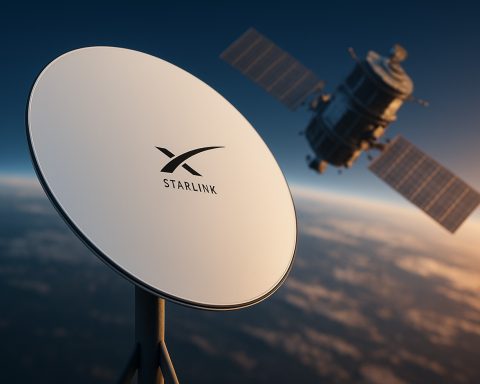- SEALSQ’s Quantum Day event highlighted the fusion of AI, semiconductors, and quantum computing as transformational forces in technology.
- The AI-Semiconductor link emphasized innovations like GPUs and neuromorphic computing, crucial for future technological developments.
- The National Quantum Initiative Act and CHIPS and Science Act were noted for fostering growth in quantum computing and semiconductor manufacturing with significant investments.
- America’s robust R&D ecosystem and tech leadership provide significant advantages, supported by vital government-industry collaborations.
- Challenges include supply chain vulnerabilities, a shortage of skilled talent, and international competition, presenting both risks and opportunities.
- The U.S. is poised for a technological renaissance, aiming for leadership through secure and innovative ecosystems.
Under the glittering lights of Nasdaq, a new era of technological ambition unfolded as industry leaders gathered for SEALSQ’s Quantum Day event. The air was charged with purpose as visionary minds probed the future of America’s semiconductor landscape.
The stage, illuminated with promise, witnessed fervent discourses on the burgeoning alliance of AI, semiconductors, and quantum computing—three grand domains poised to reshape the technological tapestry. The dialogue pivoted around the vital triad: the AI-Semiconductor nexus brimming with fresh innovations like GPUs and neuromorphic computing; quantum computing’s untapped potential bolstered by initiatives such as the National Quantum Initiative Act; and a steadfast commitment to invigorating semiconductor manufacturing with colossal investments, notably the $280 billion CHIPS and Science Act.
This narrative underscored a crucial insight: the United States, with its rich R&D ecosystem and pioneering tech leadership, holds significant advantages. Government-industry collaborations were highlighted as key arteries pumping vitality into this ecosystem, nurturing an environment ready to conquer global challenges.
Yet, lurking in the shadows are supply chain vulnerabilities, a dearth of skilled talent, and the relentless drumbeat of international competition. These challenges, as daunting as they are, also represent opportunities for innovation and growth.
The takeaway? America’s bid to cement its leadership in this synthesis of AI, semiconductors, and quantum computing is not merely a strategy; it’s a transformative vision. As the world gazes onward, the U.S. stands poised at the cusp of a technological renaissance—a leap into a future defined by secure, self-sufficient ecosystems and unfettered ingenuity.
The Future of Tech: Unveiling the Power of AI, Semiconductors, and Quantum Computing
How-To Steps & Life Hacks
For businesses and individuals looking to leverage the AI-Semiconductor-Quantum Computing triad, here’s a step-by-step approach:
1. Identify Your Needs: Understand which of the three technologies are most relevant for your operations. AI can automate processes, semiconductors improve device performance, and quantum computing solves complex problems.
2. Explore Partnerships: Collaborate with industry leaders or academic institutions specializing in these areas. Programs funded by initiatives like the National Quantum Initiative Act can offer substantial support.
3. Invest in Talent: Address the skills gap by investing in employee training or hiring experts. Government programs and tech workshops can be great resources.
4. Utilize Government Initiatives: Take advantage of funding from acts like the CHIPS and Science Act to support your tech integration.
5. Implement Secure Solutions: Prioritize cybersecurity, especially in AI implementations, to protect against vulnerabilities.
Real-World Use Cases
AI-Semiconductor Synergies
– Healthcare: AI integrated with advanced semiconductors can help in faster diagnosis and efficient patient management.
– Automotive: Neuromorphic chips aid in autonomous vehicle technologies, enhancing real-time decision-making capabilities.
Quantum Computing
– Finance: Used for risk analysis and optimization in trading algorithms.
– Pharmaceuticals: Accelerates drug discovery processes through advanced molecule modeling.
Market Forecasts & Industry Trends
The global semiconductor market is expected to surpass $800 billion by 2028 with the support of AI and quantum computing, which are anticipated to grow at a CAGR of 40% and 30% respectively during the same period. These ties reinforce competitive advantages for countries like the U.S. that invest heavily in these technologies.
Reviews & Comparisons
AI and Semiconductor Innovations
– NVIDIA vs AMD GPUs: NVIDIA often leads in AI-driven applications due to CUDA cores, but AMD’s new architecture provides strong competition with better pricing.
– Neuromorphic Chips: IBM’s TrueNorth chip focuses on power efficiency, whereas Intel’s Loihi emphasizes learning capabilities.
Controversies & Limitations
– Ethics in AI: Concerns about bias and privacy continue to shadow AI advancements.
– Quantum Computing Readiness: While promising, widespread commercialization remains distant and costly.
Features, Specs & Pricing
For those investing in technology:
– Quantum Computers: Enterprises only, pricing begins at several million dollars.
– GPUs: Range from $200 for basic models to $3000+ for high-end AI models.
– Neuromorphic Chips: Still in experimental phases, limited commercial availability.
Security & Sustainability
– Sustainability in manufacturing processes of semiconductors is a growing priority, with initiatives to reduce carbon footprints.
– AI systems must incorporate robust security frameworks to protect data integrity.
Insights & Predictions
– Progress with AI: Expect AI ecosystems to become more integrated with real-world applications beyond traditional tech spaces.
– Quantum Computing Breakthroughs: Likely within a decade, with commercial applications in cryptography and large-scale computations.
Tutorials & Compatibility
For those new to these technologies:
– Numerous online courses (Coursera, edX) offer introductory modules on AI, semiconductors, and quantum computing.
– Compatibility with existing infrastructure often requires tailored solutions.
Pros & Cons Overview
Pros
– AI: Exemplary in automating tasks and scaling efficiency.
– Quantum Computing: Unparalleled problem-solving potential.
– Semiconductors: Rapidly increasing processing power and reducing energy costs.
Cons
– AI: Regulatory and ethical issues.
– Quantum Computing: Significant resource investment needed.
– Semiconductors: Supply chain vulnerabilities.
Actionable Recommendations
– Short-term: Invest in skill development focused on these emerging technologies.
– Mid-term: Establish collaborations with industry leaders.
– Long-term: Develop a roadmap for tech integration incorporating sustainable practices.
In conclusion, as we stand on the brink of this technological renaissance, embracing these tools ensures not just survival but leadership in the ever-evolving tech landscape. For further insights into evolving tech trends, visit Forbes or TechCrunch for more updates.











